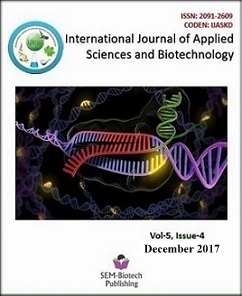Biosynthesis of Silver Nanoparticles Using Ganoderma Lucidum and Assessment of Antioxidant and Antibacterial Activity
DOI:
https://doi.org/10.3126/ijasbt.v5i4.18776Keywords:
silver nanoparticles (Ag-NPs), Ganoderma lucidum, X-ray diffraction, FTIR-ATR, antimicrobial activity, synergistic effectAbstract
There is an increasing interest these days in the green route of synthesis of metal nanoparticles using plant extract, fungus and bacterial- mediated eco-friendly materials. Silver nanoparticles were synthesized using an intracellular extract of Ganoderma lucidum, a mushroom from Nepal then characterization of silver nanoparticles was performed. The Ag-NPs thus formed show surface plasmonic resonance with a maximum absorption band at 420 nm. Their crystalline nature was confirmed as a face-centered cubic structure by the XRD, Furthermore, SEM revealed that they were in the size range of 10-30 nm and were spherical in shape. The possible biomolecule involved in the reduction and stabilization of Ag-NPs were believed to be oxidized polyphenol, and carbonyl group, amino acid residue. Ag-NPs exhibit good antioxidant activity but showed low antioxidant in comparison to the fungal extract alone, which was studied using DPPH antioxidant assay. The effect of the colloidal silver nanoparticles solution against six human pathological bacteria was carried out by Disc diffusion method. The zone of maximum inhibition was seen in Bacillus subtilis (17.0 ± 0.13 mm) and least effective against Escherichia coli (10.1 ± 0.2 mm). Further, the results showed that Ag-NPs in combination with antibiotics have better antibacterial effect as compared with Ag-NPs alone. The maximum effect with a 3.2 and 5.3 fold increase was seen in Gentamicin and Streptomycin respectively providing the synergistic role of Ag-NPs. The results of antimicrobial studies indicated that the Ag-NPs are the metal of choice and can be effectively used in combination with antibiotics in order to improve their efficiency against various pathogenic microbes.
Int. J. Appl. Sci. Biotechnol. Vol 5(4): 523-531




